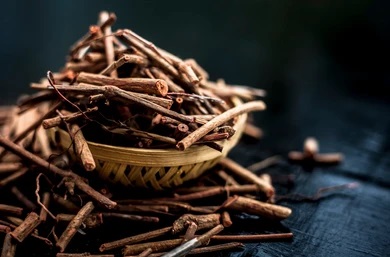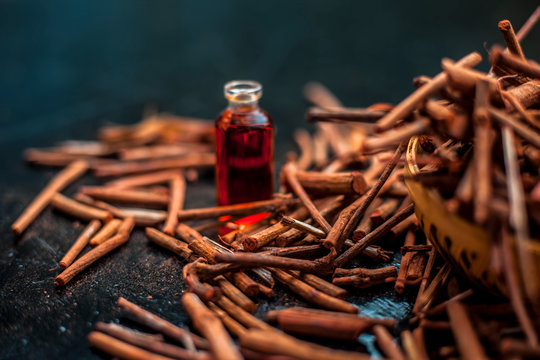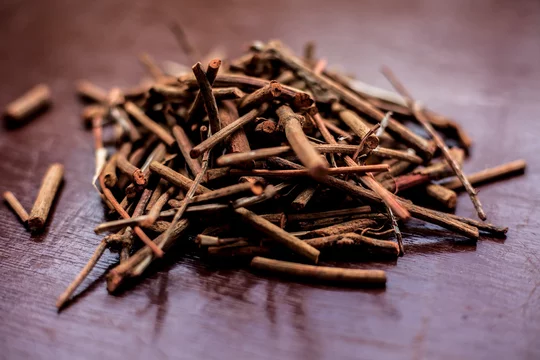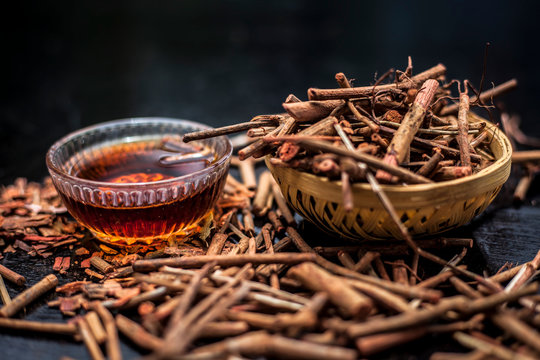Introduction

Madder is a plant (Rubia tinctorum) known for its roots, which have been used for centuries to produce a red dye. Native to the Mediterranean and Asia, madder was historically a primary source of red, pink, and purple dyes in textiles. The dye, called alizarin, was used extensively before the advent of synthetic dyes in the 19th century. Additionally, madder lake, a pigment derived from the dye, became popular in European art, valued for its warm red tones.
Other names: Majith Nepali, Manjistha, Manjit, Majeeth.
Medicinal property
In a medicinal context, madder (Rubia tinctorum) has been used in traditional medicine for its various properties. Historically, it was believed to have diuretic, anti-inflammatory, and blood-purifying effects. It was used to treat conditions like urinary tract disorders, kidney stones, and jaundice. However, modern usage is limited due to potential toxicity, and it is no longer commonly recommended in contemporary medicine.
Forms
Madder (Majeeth) is available in various forms, each used differently depending on the intended purpose. Some of the common forms include:

- Powder: Madder root is often ground into a fine powder, which can be used in face masks, creams, or taken orally as a supplement. The powder is commonly used for treating skin conditions like acne, pigmentation, and infections.
- Capsules or Tablets: Madder extract is sometimes available in the form of capsules or tablets, typically used for internal medicinal purposes, such as supporting kidney health or promoting detoxification.
- Tea or Decoction: Madder root can be boiled to make a tea or decoction, which is consumed for internal benefits like blood purification, menstrual regulation, and improving skin from within.
- Oil: Madder-infused oil is used topically for skin care, wound healing, and reducing pigmentation. It can be mixed with other carrier oils or applied directly to the skin.
- Tincture: A tincture made from madder root is an alcohol-based extract used in small amounts for medicinal purposes, often taken orally.
- Topical Paste: Madder powder can be mixed with water, rose water, or other herbal ingredients to create a paste, which is applied directly to the skin for treating wounds, acne, or pigmentation issues.
Health Benefits
Madder (Majeeth) has been used in traditional medicine for various health benefits, although modern research is limited. Some potential health benefits of madder include:
Blood Purifier
This is the primary function of manjistha herb is the purification of blood. Purified blood is necessary to have good skin and hair. Manjistha is a great blood purifier. It cleanses the blood and removes all toxins from it. Symptoms of skin diseases are effectively tackled by manjistha. It also boosts immunity levels.

Menstrual Pain
Some women experience excruciating pain during their menstrual cycle. Manjistha powder is beneficial during painful menstruation and post-natal ailments that affect the uterus.
Removes Gall Bladder Stones
Manjistha herb cleans and regulates the pancreas, spleen, liver, and kidneys. All of these organs have a role in digestion and cleansing of the body. By regulating these organs, manjistha indirectly promotes proper digestion and a clean bodily system.
Detoxification
Manjistha tablet is a very useful herb for people who are in the habit of eating toxic diet or are suffering from toxic emotions or people who are in the process of detoxifying their bodies. It is a wonderful support to the immune system since it eliminates toxins that could become overwhelming to it and increase blockages in the body.
Skin Health
Madder (Majeeth) has been traditionally used for various skin health benefits. It is believed to promote wound healing, reduce inflammation, and prevent infections when applied externally to cuts or ulcers. With its antimicrobial properties, madder has also been used to treat skin infections, rashes, and acne. Additionally, it is thought to help with hyperpigmentation, potentially lightening dark spots and improving skin tone. Due to its antioxidant properties, madder may also offer anti-aging benefits by protecting the skin from oxidative damage. However, its use should be approached with caution, and it’s advisable to consult a healthcare professional before using it for skin treatments.
Hair Health

Madder (Majeeth) is believed to strengthen hair, promote growth, and improve scalp health due to its anti-inflammatory and antimicrobial properties. It may also help reduce hair loss, condition hair, and was historically used as a natural hair dye. Always consult a healthcare provider before use.
Diabetic Neuropathy
People suffering from diabetes sometimes develop ulcers in the leg. This is a debilitating condition and should be treated as soon as they start appearing. Manjistha has the capability to heal diabetic ulcers. It can be consumed in the form of capsules or decoction.
Promotes Healing of injury
Manjistha is an ayurvedic medicine benefit which incur cuts and bruises on our body whereby skin tissues get damaged. Manjistha promotes the healing of skin tissues damaged by injury or infection.
Side Effects
While madder (Majeeth) has been traditionally used for its medicinal properties, it can also have side effects, especially if used inappropriately or in large amounts. Some potential side effects include:

- Toxicity
- Kidney Damage
- Gastrointestinal Issues
- Skin Sensitivity
- Allergic Reactions
- Blood Disorders
- Headaches
- Dizziness
- Skin Irritation




